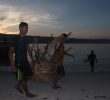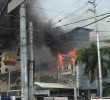Protection and humanitarian needs
Armed confrontation between the MILF rebels and the government tends to be of a conventional positional type, often affecting the same communities who live near the MILF camps over and over again. With the fighting often taking place within the villages themselves, clashes with the MILF also often result in large civilian casualties and destruction of property as well as large-scale displacement of people who often need to be accommodated in evacuation centres. Although large armed confrontations such as the 2000 and 2003 wars have been successfully avoided in the past three years, fighting incidents leading to population movements have occurred with an alarming regularity in Mindanao. Often triggered by land or clan disputes, many small incidents degenerate into wider confrontations involving paramilitary groups, rebel groups and government forces. Caught in the crossfire, civilians and displaced people in particular are vulnerable to a range of direct threats to their physical security including stray bullets or bombs, but also harassment and physical abuse by the military. In January 2007, four IDPs displaced by fighting in Midsayap, North Cotabato were reportedly apprehended by a military unit and subjected to physical abuse while attempting to return to their homes to fetch food and other personal items (Luwaran, 5 February 2007). In November 2006, two women aid workers visiting displaced families in the same province were abducted and sexually molested by Philippine soldiers (Davao Today, 13 November 2006).
Whereas displacement caused by armed encounters between the NPA rebels and government forces tends to be comparatively smaller in scale than those involving MILF rebels, mainly because the incidents tend to take place at some distance from the villages, the protection needs of the civilians and displaced population tend to be as important. Indeed, counter-insurgency operations conducted by the military frequently result in human rights abuses against civilians suspected of supporting the insurgents. According to a UNICEF study covering the period 2001-2005, the military strategy of the armed forces during counter-insurgency operations against the NPA has tended to explicitly disregard the distinction between combatants and civilians. Even more alarming, the official military strategy against terrorism appeared to consider anyone suspected of associating with terrorists as legitimate military targets (UNICEF, October 2006, pp. 35-36).
In addition to human rights abuses resulting from counter-insurgency operations, it should be noted that politically motivated extra-judicial killings in the country during 2006 reached their highest level since 1986 with more than 180 people killed, including human rights activists, trade unionists and leftist militants. This dramatic deterioration of the human rights situation prompted the UN special rapporteur on extra-judicial killings to visit the Philippines in February 2007 (UN, 21 February 2007).
The daily environment of the majority of people living in conflict-affected areas of Mindanao, most of which are in the Autonomous Region of Muslim Mindanao, is one of constant economic as well as physical insecurity. Already living in the provinces that rank the lowest in terms of human and economic development (incidence of poverty in the ARMM region is 63 per cent), people at risk of displacement due to fighting tend to belong to the poorest strata of society. Most of the close to two million people displaced in Mindanao since 2000 are Muslims or indigenous people, the latter being often caught in the crossfire or displaced from their lands by government-sponsored development projects. As such, the displaced are the immediate but also the long-term victims of the conflict between the government and the various insurgent groups active in the Philippines. The recurrent nature of fighting and displacement in Mindanao means that the assistance needs of the displaced range from immediate humanitarian relief, characteristic of short-term emergency situations, to more development-oriented assistance schemes such as those needed in post-conflict settings.










